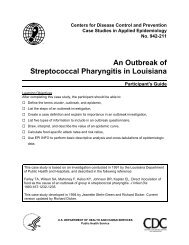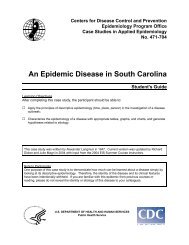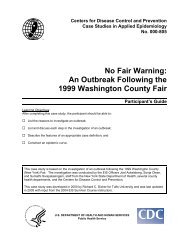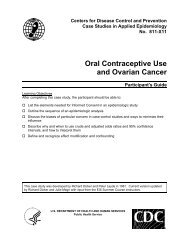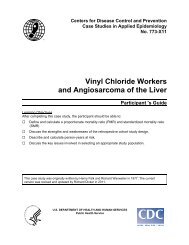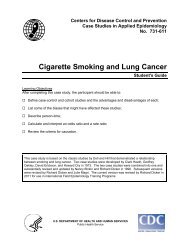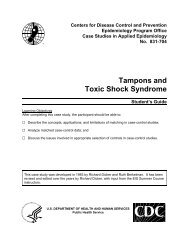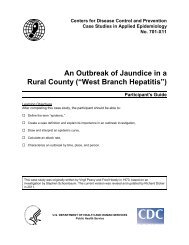Case studies\Xtexarkana\Xtexark.711-505.student.wpd - Library
Case studies\Xtexarkana\Xtexark.711-505.student.wpd - Library
Case studies\Xtexarkana\Xtexark.711-505.student.wpd - Library
You also want an ePaper? Increase the reach of your titles
YUMPU automatically turns print PDFs into web optimized ePapers that Google loves.
Centers for Disease Control and Prevention<br />
Epidemiology Program Office<br />
<strong>Case</strong> Studies in Applied Epidemiology<br />
No. 711-505<br />
Texarkana —<br />
Epidemic Measles in a Divided City<br />
Learning Objectives<br />
After completing this case study, the participant should be able to:<br />
Student's Guide<br />
G<br />
G<br />
G<br />
Discuss the advantages and disadvantages of using a sensitive and/or specific case<br />
definition in an epidemic investigation;<br />
Calculate vaccine efficacy and discuss its interpretation; and<br />
Discuss the advantages and limitations of selecting a specific age as the recommended<br />
target date for administering vaccinations.<br />
This case study is based on an investigation by Philip Landrigan, EIS ‘70. The investigation<br />
is described in:<br />
Landrigan PJ. Epidemic measles in a divided city. JAMA 1972; 221: 567-570.<br />
This case study was original developed by Philip Landrigan, Lyle Conrad and John Witte in<br />
1971. The current version was updated by Richard Dicker in 2001 and 2003.<br />
U.S. DEPARTMENT OF HEALTH AND HUMAN SERVICES<br />
Public Health Service
CDC-EIS, 2005: Texarkana: Measles in a Divided City (711-505) – Student’s Guide Page 2<br />
PART I<br />
On Tuesday, November 3, 1970, the Center for<br />
Disease Control (CDC) in Atlanta received the<br />
weekly telegram of surveillance data from the<br />
Texas State Health Department. The telegram<br />
reported 319 cases of measles in the state<br />
during the previous week. In contrast, Texas<br />
had reported an average of 26 cases per week<br />
during the previous four weeks. In follow-up<br />
telephone calls, CDC learned from State health<br />
officials that 295 cases of measles had been<br />
diagnosed in the city of Texarkana, including 25<br />
in children reported to have been previously<br />
immunized.<br />
An invitation to investigate the situation was<br />
extended to the CDC on November 4, 1970. An<br />
EIS officer departed for Texarkana early on<br />
November 5.<br />
Background<br />
Texarkana is a city of roughly 50,000 that<br />
straddles the Texas-Arkansas state line.<br />
Texarkana, Texas (Bowie County), had a<br />
population of 29,393 in the 1960 census; the<br />
population had been stable during the 1960s.<br />
Texarkana, Arkansas (Miller County), had a<br />
1960 population of 21,088.<br />
Although Texarkana is divided by the state line,<br />
it is a single town economically and socially.<br />
Persons of all ages on both sides of town have<br />
frequent contact. Churches, physicians, offices,<br />
movie theatres, and stores draw people from<br />
both the Arkansas and Texas sides of town.<br />
People cross the state line to attend social<br />
functions such as football games and school<br />
dances. Many families have friends and<br />
relatives who visit back and forth on both sides<br />
of town. Private nurseries and kindergartens<br />
receive children from both sides of town. The<br />
two sides of Texarkana, however, do have<br />
separate public school systems and separate<br />
public health departments.<br />
Question 1:<br />
List the reasons to investigate a suspected outbreak. Which reasons may have<br />
prompted an investigation of this outbreak?
CDC-EIS, 2005: Texarkana: Measles in a Divided City (711-505) – Student’s Guide Page 3<br />
Question 2a: What would be the initial steps of your investigation, i.e., the steps before trying to find<br />
additional cases?<br />
Question 2b: How might you look for additional cases?<br />
Question 2c: Once you collected information about the cases, how would you characterize the<br />
outbreak?
CDC-EIS, 2005: Texarkana: Measles in a Divided City (711-505) – Student’s Guide Page 4<br />
PART II<br />
The Investigation<br />
The investigators obtained names of cases from<br />
the health departments, physicians, school and<br />
nursery records. They conducted a door-to-door<br />
survey. They also asked families of cases for<br />
names of other cases. They used the same<br />
methods of case-finding and epidemiologic<br />
investigation on both the Arkansas and Texas<br />
sides of town.<br />
Clinical Picture<br />
The illness was clinically compatible with<br />
measles. Typically, the patients had a 4- to<br />
5-day prodrome with high fever, coryza (runny<br />
nose), cough, and conjunctivitis (red, irritated<br />
eyes) followed by the appearance of a bright<br />
maculopapular (red spots and areas) rash. The<br />
temperature usually returned to normal 2 to 3<br />
days after appearance of the rash, while the<br />
rash persisted for 5 to 7 days.<br />
Question 3:<br />
How might you define a case for purposes of this investigation?<br />
Question 4:<br />
Describe the difference between a sensitive case definition and a specific case<br />
definition. What are the advantages and disadvantages of each? Provide an example<br />
of a situation where each would be helpful.
CDC-EIS, 2005: Texarkana: Measles in a Divided City (711-505) – Student’s Guide Page 5<br />
In Texarkana, the investigators defined a case as an "illness which is clinically compatible with measles."<br />
Question 5:<br />
Critique this case definition.
CDC-EIS, 2005: Texarkana: Measles in a Divided City (711-505) – Student’s Guide Page 6<br />
The Outbreak<br />
Between June 1970 and January 1971, 633<br />
cases of measles were reported from<br />
Texarkana. Dates of onset were accurately<br />
determined for 535 cases. The epidemic curve<br />
is shown below.<br />
Measles cases by week of onset, Texarkana, Texas and Arkansas,<br />
June 28, 1970 - January 29, 1971<br />
80<br />
70<br />
60<br />
School<br />
Preschool<br />
Unknow n<br />
Vaccination<br />
Campaigns<br />
# cases<br />
50<br />
40<br />
30<br />
20<br />
10<br />
0<br />
Opening<br />
of schools<br />
28-Jun<br />
12-Jul<br />
26-Jul<br />
9-Aug<br />
23-Aug<br />
6-Sep<br />
20-Sep<br />
4-Oct<br />
18-Oct<br />
1-Nov<br />
15-N ov<br />
29-Nov<br />
13-D ec<br />
27-Dec<br />
10-Jan<br />
24-Ja n<br />
Week of onset<br />
Question 6:<br />
Discuss the key features of the epidemic that you can derive from the epidemic curve.
CDC-EIS, 2005: Texarkana: Measles in a Divided City (711-505) – Student’s Guide Page 7<br />
Though infants, adolescents, and adults were<br />
involved in the epidemic, the majority of cases<br />
occurred in children 1 to 9 years of age.<br />
Measles cases were not evenly distributed<br />
within the two counties. Table 1 displays the<br />
number of measles cases and population by age<br />
group for Bowie County, Texas and in Miller<br />
County, Arkansas.<br />
Table 1. Number of measles cases and population (1960 census) by age group and county, Texarkana<br />
outbreak, 1970<br />
Urban/ Age<br />
Residence Rural Group # <strong>Case</strong>s Population Rate<br />
Bowie Co., Texas Rural 1-4 yr 47 2,452<br />
5-9 178 3,242<br />
1-9<br />
Urban 1-4 195 2,481<br />
5-9 73 3,010<br />
1-9<br />
Total 1-4 242 4,933<br />
5-9 251 6,252<br />
Miller Co., Arkansas Total 1-4 19 2,671<br />
1-9<br />
5-9 6 3,345<br />
1-9<br />
Question 7: Calculate the totals and attack rates indicated in Table 1.<br />
Question 8: Discuss the differences in attack rates for the Texas and Arkansas counties, for rural<br />
versus urban children, and for preschool versus school-age children.
CDC-EIS, 2005: Texarkana: Measles in a Divided City (711-505) – Student’s Guide Page 8<br />
Part III<br />
Measles in Previously Vaccinated Children<br />
Before this outbreak, the proportion of children<br />
vaccinated against measles on the Arkansas<br />
side was substantially higher than the proportion<br />
vaccinated on the Texas side. The Texas side<br />
had never had a community or school<br />
vaccination campaign for measles. In contrast,<br />
the Arkansas side had held mass community<br />
programs against measles for school and<br />
pre-school children in 1968 and 1969.<br />
Based on health department and physician<br />
records, investigators estimated that over 99%<br />
of children aged 1-9 years in Miller County,<br />
Arkansas had received measles vaccine prior to<br />
the outbreak. The overall vaccination level in<br />
Bowie County, Texas, was estimated to be 57%.<br />
In this outbreak, 27 of the measles cases in<br />
Bowie County and all 25 of the measles cases in<br />
Miller County gave a history of prior vaccination<br />
with live attenuated measles-virus vaccine.<br />
Parental history of vaccination was corroborated<br />
for all the cases by clinic or physician records.<br />
Local health authorities in both counties were<br />
very concerned that children who had previously<br />
received measles vaccine got the disease.<br />
Question 9: Calculate attack rates among the vaccinated populations in both counties and comment<br />
on your findings.
CDC-EIS, 2005: Texarkana: Measles in a Divided City (711-505) – Student’s Guide Page 9<br />
Table 2. Hypothetical populations with vaccine coverage of 0%, 20%, 60%, and 100%<br />
Population<br />
W X Y Z<br />
a. Number of persons in population 100 100 100 100<br />
b. Vaccine efficacy (VE) 90% 90% 90% 90%<br />
c. Percent population vaccinated (PPV) 0% 20% 60% 100%<br />
d. Number vaccinated (a × c) _____ 20 _____ _____<br />
e. Number unvaccinated (a ! d) _____ 80 _____ _____<br />
f. Number protected (d × b) _____ 18 _____ _____<br />
g. Number vaccinated but ill (d ! f) _____ 2 _____ _____<br />
h. Total number ill (e + g) _____ 82 _____ _____<br />
i. Percent cases vaccinated (PCV) (g / h) _____ 2.4% _____ _____<br />
Consider the use of a vaccine with 90% efficacy<br />
in four different hypothetical populations of 100<br />
people each, with vaccine coverage of 0%,<br />
20%, 60%, and 100%, respectively. Assume<br />
that every unvaccinated person will be exposed<br />
to, and will develop, measles.<br />
Question 10: Complete Table 2.<br />
Question 11:<br />
What do you conclude about the relationship between coverage and number of cases<br />
vaccinated? What might your public health message be for these data?
CDC-EIS, 2005: Texarkana: Measles in a Divided City (711-505) – Student’s Guide Page 10<br />
Vaccine Efficacy<br />
The ability of a vaccine to prevent disease<br />
depends on its potency and proper<br />
administration to an individual capable of<br />
responding. The success of vaccination<br />
performed under field conditions may be<br />
assessed by measuring protection against<br />
clinical disease. Such field assessments can be<br />
very useful, particularly when doubt is cast on<br />
the efficacy of the vaccine because of the<br />
occurrence of disease among vaccinated<br />
persons.<br />
Vaccine efficacy is measured by calculating the<br />
incidence (attack rates) of disease among<br />
vaccinated and unvaccinated persons and<br />
determining the percentage reduction in<br />
incidence of disease among vaccinated persons<br />
relative to unvaccinated persons. The greater<br />
the percentage reduction of illness in the<br />
vaccinated group, the greater the vaccine<br />
efficacy. The basic formula is written as:<br />
VE =<br />
ARU − ARV<br />
× 100<br />
ARU<br />
where<br />
VE = vaccine efficacy,<br />
ARU = attack rate in the unvaccinated<br />
population; and<br />
ARV = attack rate in the vaccinated population.<br />
Question 12:<br />
Using the basic formula, calculate vaccine efficacy for Bowie County, Texas.<br />
Question 13:<br />
Was inadequate vaccine efficacy primarily responsible for this outbreak? If not, what<br />
is your alternative explanation?<br />
Question 14:<br />
What are the possible causes for the failure of the vaccine to protect vaccinated<br />
children from acquiring disease?
CDC-EIS, 2005: Texarkana: Measles in a Divided City (711-505) – Student’s Guide Page 11<br />
Part IV<br />
In previously vaccinated children aged 1-9 years<br />
in Bowie County, the measles attack rate in this<br />
outbreak was 4.2 per 1000; the comparable rate<br />
in unvaccinated children was 96.9 per 1000.<br />
From these data, a vaccine efficacy of 95.7<br />
percent was calculated. This is a minimum<br />
figure since it has been assumed that all 27<br />
children were correctly vaccinated and that all of<br />
the cases therefore represent vaccine failure.<br />
In actuality some of these patients did not<br />
receive vaccine under ideal conditions. Eight of<br />
the 27 previously vaccinated patients had been<br />
vaccinated by nurses from the Texarkana/Bowie<br />
County Health Unit at a day nursery. The<br />
vaccine for these eight children had been<br />
carried back and forth to the nursery from the<br />
Health Unit in a cooler in a car on three separate<br />
days in June and July 1970. Although a lapse in<br />
technique which allowed warming of the vaccine<br />
cannot be documented here, it is a possible<br />
explanation.<br />
An additional seven patients had been<br />
vaccinated under the age of 1 year. These<br />
children were vaccinated in the years 1963-67<br />
when it was recommended that measles vaccine<br />
be given at age 9 months. It has since been<br />
learned that a vaccine failure rate as high as<br />
15% may accompany vaccination at 9 months in<br />
the United States.<br />
Question 15:<br />
What is the WHO recommended age for measles vaccination in developing countries?<br />
Why is the recommended age for vaccination different in the United States?
CDC-EIS, 2005: Texarkana: Measles in a Divided City (711-505) – Student’s Guide Page 12<br />
PART V - CONCLUSION<br />
Prior to the development of a vaccine, about<br />
500,000 people developed measles in the<br />
United States annually; 50% of persons<br />
contracted the disease by age 6 years and 90%<br />
by age 15 years. In 1963 both a killed measles<br />
vaccine (KMV) and a live, attenuated vaccine<br />
were licensed. Since 1969 only live attenuated<br />
vaccine has been used in this country.<br />
At the time of original licensure in 1963, the<br />
recommended age of vaccination in the United<br />
States was 9 months. The recommended age<br />
was raised to 12 months in 1965 and to 15<br />
months in 1976.<br />
Compared with the pre-vaccination era, the<br />
occurrence of measles in the U.S. declined by<br />
more than 99% by the late 1980s. However,<br />
measles cases increased in 1989–1991, and a<br />
two-dose strategy was adopted. The<br />
recommended age for the first dose is 12–15<br />
months; the recommended age for the second<br />
dose is 4–6 years. After the adoption of the twodose<br />
strategy and a substantial increase in<br />
immunization program resources, measles<br />
cases again declined. Since 1997, fewer than<br />
140 cases of measles have been reported each<br />
year in the United States, almost all of which<br />
could be traced to imported cases. The<br />
provisional totals for 2002 and 2003 were record<br />
lows of 44 and 42 cases, respectively.<br />
REFERENCES<br />
1. Landrigan PJ. Epidemic measles in a divided city. JAMA 1972; 221: 567-570.<br />
2. CDC. <strong>Case</strong> definitions for infectious conditions under public health surveillance. MMWR<br />
1997;46(No. RR-10):23-24.<br />
3. WHO. Core information for the development of immunization policy: 2002 update. Geneva: World<br />
Health Organization, 2003.<br />
ADDITIONAL READING<br />
1. Orenstein WA, Bernier RH, Hinman AR. Assessing vaccine efficacy in the field: further<br />
observations. Epidemiologic Reviews 1988; 10: 212-241.<br />
2. CDC. Measles, mumps, and rubella – vaccine use and strategies for elimination of measles, rubella<br />
and congenital rubella syndrome and control of mumps: recommendations of the Advisory<br />
Committee on Immunization Practices (ACIP). MMWR 1998; 47 (No. RR-8): 1-57.




